How Strong is The Australian Army - 17th Powerful Militaries In The World
 |
| Australia - 17th Strongest Militaries In The World |
The Australian Army is the principal land warfare force of Australia, a part of the Australian Defence Force (ADF) along with the Royal Australian Navy and the Royal Australian Air Force. The Army is commanded by the Chief of Army (CA), who is subordinate to the Chief of the Defence Force (CDF) who commands the ADF. The CA is also directly responsible to the Minister for Defence, with the Department of Defence administering the ADF and the Army.
Take a look at the history, strength and powers, and how Australia has the world’s 17th strongest militaries.
Australia's Army
Formed in 1901, as the Commonwealth Military Forces, through the amalgamation of the colonial forces of Australia following the Federation of Australia. Although Australian soldiers have been involved in a number of minor and major conflicts throughout Australia's history, only during the Second World War has Australian territory come under direct attack.
The Australian Army was initially composed almost completely of part–time soldiers, where the vast majority were in units of the Citizens Military Force (CMF or Militia) (1901–1980) during peacetime, with limits set on the regular Army. Since all reservists were barred from forcibly serving overseas, volunteer expeditionary forces (1st AIF, ANMEF, 2nd AIF) were formed to enable the Army to send large numbers of soldiers to serve overseas during periods of war. This period lasted from federation until post–1947, when a standing peacetime regular infantry force was formed and the Australian Army Reserve (1980–present) began to decline in importance.
During its history, the Australian Army has fought in a number of major wars, including the Second Boer War, the First and Second World Wars, Korean War, Malayan Emergency, Indonesia-Malaysia Confrontation, Vietnam War, and more recently in Afghanistan and Iraq. Since 1947, the Australian Army has also been involved in many peacekeeping operations, usually under the auspices of the United Nations. Today, it participates in multilateral and unilateral military exercises and provides emergency disaster relief and humanitarian aid in response to domestic and international crises.
How strong is Australian military?
The Australian Defence Force (ADF) is the military organisation responsible for the defence of the Commonwealth of Australia and its national interests. It consists of the Royal Australian Navy (RAN), Australian Army, Royal Australian Air Force (RAAF) and several "tri-service" units. The ADF has a strength of just over 85,000 full-time personnel and active reservists and is supported by the Department of Defence and several other civilian agencies.
During the first decades of the 20th century, the Australian Government established the armed services as separate organisations. Each service had an independent chain of command. In 1976, the government made a strategic change and established the ADF to place the services under a single headquarters. Over time, the degree of integration has increased and tri-service headquarters, logistics, and training institutions have supplanted many single-service establishments.
The ADF is technologically sophisticated but relatively small. Although the ADF's 58,206 full-time active-duty personnel and 29,560 active reservists As of 2020 make it the largest military in Oceania, it is smaller than most Asian military forces. Nonetheless, the ADF is supported by a significant budget by worldwide standards and can deploy forces in multiple locations outside Australia.
Australian Military weapons
The Australian Army is equipped with a wide range of equipment in order to be able to employ combined arms approaches in combat. As of 2016, the Army's armoured fighting vehicle holdings included 59 M1A1 Abrams main battle tanks, 1,426 M113 armoured personnel carriers (of which 431 had been upgraded, with many of the remainder being placed in reserve), and 253 ASLAV armoured reconnaissance vehicles. A total of 995 Bushmaster Protected Mobility Vehicles were in service with more on order. The Army's artillery holdings consisted of 54 155 mm towed M777 howitzers, 188 81 mm mortars, RBS-70 surface-to-air missiles and FGM-148 Javelin anti-tank missiles. As of October 2017, Australian Army Aviation operated over 100 helicopters. These included including 23 Kiowa reconnaissance and training helicopters and 22 Eurocopter Tiger armed reconnaissance helicopters, as well as 33 S-70A-9 Blackhawk, 10 CH-47F Chinook and 40 MRH 90 transport helicopters. The Army also operated 10 RQ-7B Shadow 2000 unmanned aerial vehicles in 2016. The Army's fleet of watercraft at this time included 13 LCM-8 landing craft.
The Royal Australian Air Force operates combat, maritime patrol, transport and training aircraft. As at October 2017 the combat aircraft force comprised 71 F/A-18A and B Hornets, 24 F/A-18F Super Hornets, 12 EA-18G Growlers and 2 F-35A Lightning IIs with another 70 on order. The Intelligence, surveillance and reconnaissance force was equipped with 13 AP-3C Orion and 4 P-8 Poseidon maritime patrol aircraft as well as 6 E-7A Wedgetail AEW&C aircraft. The air transport force operated 12 C-130J-30 Super Hercules, 8 C-17 Globemaster IIIs and 7 C-27J Spartans with 3 on order. A further 16 Super King Air 350s were used in both the transport and training roles. The RAAF also operates 3 Challenger and 2 Boeing 737 aircraft as VIP transports. A total of six KC-30 Multi-Role Tanker Transports were in service with another on order. The RAAF's training units were equipped with 62 PC-9s, 10 PC-21s (with another 39 on order) and 33 Hawk 127s.
Armoured vehiclesASLAV - The Army operates 257 ASLAV-25 vehicles, in a variety of roles including formation reconnaissance, as an infantry fighting vehicle, armoured ambulance or recovery vehicle. Australia Bushmaster PMV - The Army has ordered a total of 1,052 Bushmaster Protected Mobility Vehicles to date, with deliveries commencing in mid-2005. Bushmasters primarily equip the Motorised Infantry 7th Brigade, B Squadron, 3rd/4th Cavalry Regiment also operate armoured vehicles in support of the 3rd Brigade, 1st Combat Engineer Regiment, 2nd Combat Engineer Regiment, and 3rd Combat Engineer Regiment, as well as the heavy weapons and support elements of two mechanized battalions and three light infantry battalions. United States M1A1 Abrams - 59 M1A1 Abrams and five M88 Hercules were purchased to replace the Leopard AS1 in service with the 1st Armoured Regiment. The first M1 equipped sub-units of the regiment became operational in mid-2007. The Abrams is the most powerful vehicle in the Australian inventory. While retaining the gas turbine engines, the Australian Abrams tanks use diesel fuel instead of the kerosene based JP-8 that powers American Abrams tanks. United States M113 - The Army has 700 M113 vehicles, which are used in the armoured reconnaissance and armoured personnel carrier roles, primarily by the Army's two mechanised infantry battalions. 431 have been upgraded to M113AS3/4 standard and are currently in service. United Kingdom Nary HMT 400 - The Army has purchased 31 Nary patrol vehicles for use by the SASR, its size and light weight allow it to be ferried by a Chinook helicopter. Its namesake comes from Warrant Officer David Nary who was the first Australian soldier killed during the Iraq War. In addition Supacat's HMT Extenda has been selected as part of the Australian Army's JP2097 Ph 1B (REDFIN) program. ArtilleryUnited Kingdom L119 Hamel Gun - The 105 mm field artillery is currently used by Reserve units. United Kingdom M777 howitzer - Thirty-five 155 mm M777s were ordered as part of the first phase of the Land 17 project to replace the Army's inventory of towed artillery, with initial deliveries beginning in late 2010. An additional 19 guns were purchased in late 2012 instead of the self-propelled guns previously planned, bringing the total order to 54. United States M198 howitzer - Thirty-six 155 mm M198 howitzers are currently used by Reserve artillery regiments. Sweden RBS-70 - The RBS-70 is a man portable SAM system used by the Australian Army for air defence. More sophisticated Bolide missiles have now been purchased. AircraftFrance / Germany ARH Tiger - 'Armed Reconnaissance Helicopter', modified and upgraded version of the Tiger HAP. European Union MRH-90 - Medium lift/utility helicopter replacing the UH-1 Iroquois in 2008, and eventually the Blackhawks. United States S-70A Blackhawk - The Sikorsky S-70-A9 Blackhawk is the Army's primary battlefield lift/utility helicopter. The helicopters were assembled by Hawker de Havilland. Eventually to be replaced by the MRH-90. United States CH-47 Chinook - The Army operates Chinooks in the heavy lift role. United States OH-58 Kiowa - The Kiowa is utilised in the reconnaissance and battlefield surveillance role. It is being replaced by the Tiger armed reconnaissance helicopter. Infantry weaponsAustria / Australia F88 Austeyr - a derivative of the Austrian Steyr AUG STG-77 assault rifle. It is the ADF's standard individual weapon, which replaced the L1A1 SLR and the M16A1 rifle from front-line service in the late 1980s. The rifle uses an Australian 5.56x45mm cartridge with a modified propellant. According to the ADF, the modified bullet is more accurate and goes further but costs more to make. The F88 Austeyr can use the 5.56x45mm NATO round but under continued use, damages the barrel. The rifle has a 508 mm barrel and an integral 1.5x magnified optical sight inside the carry handle. The weapon is manufactured under licence in Australia by Thales Australia (formerly Australian Defence Industries Ltd). Variants include: F88C Austeyr - carbine variant, fitted with a 407 mm barrel and is normally issued to personnel serving with space constraints and weight constraints (e.g. Cavalry, Light Horse and Paratroopers). It is also currently used by Reserve units but is in the process of being phased out. F88S-A1 Austeyr - updated version that is issued to front-line combat infantry units. The rifle has the full length 508mm barrel and has a flat top receiver with a long MILSTD 1913 'Picatinny' rail to accommodate specialised optical devices and accessories. F88S-A1C Austeyr - updated 407 mm barreled carbine variant, with a MILSTD 1913 'Picatinny' rail. F88S-A2 Austeyr - an evolutionary upgrade of the current rifle to fulfill an operational capability gap. Deliveries of several thousand were completed in late-2009 to selected units for overseas service. Technical improvements in the F88SA2 include: a larger Picatinny Rail on top of the weapon, a modified sight housing, and a side rail mount for a torch and Night Aiming Devices (NAD). The colour of the weapon has also been changed to khaki to reduce the recognition signature.[5] This variant is currently replacing all previous models. United States M4A1 Carbine - used by various Australian special forces units. It is also issued to crew members of the Abrams battle tanks and Tiger helicopters. Its official designation in Australia is the M4A5. Precision riflesUnited Kingdom SR-98 - an Australian variant of the bolt action Accuracy International Arctic Warfare rifle, it is the standard-issue sniper rifle in the Australian Army and is chambered for 7.62x51mm. It replaced the Parker Hale Model 82 rifle in the late 1990s. Manufactured under licence in Australia by Thales Australia. United Kingdom AW50F - the AW50F is the largest-bore variant of the Arctic Warfare sniper rifles suited to the anti-materiel role. It is chambered for the .50 BMG cartridge, and is primarily used with Raufoss Mk211 HEIAP rounds. The AW50F was designed with an Australian-designed and manufactured barrel. Germany Blaser 93 Tactical 2 - a straight-pull bolt action sniper rifle chambered in .338 Lapua Magnum. The rifle has been observed in service with special forces and infantry units in Afghanistan. Germany Heckler & Koch HK417 - 'Marksman Rifle System' used by infantry and special forces units to fill the gap between a sniper rifle and 5.56mm derivatives. United States SR-25 - a semi-automatic 7.62 x 51 mm sniper rifle. It has recently been observed in service with reconnaissance and special forces units of the Australian Army. It has seen service in Iraq, Afghanistan and East Timor. United States Mk 14 Enhanced Battle Rifle (M14EBR) - small numbers borrowed from American forces were used by Australian special forces in Afghanistan. Machine gunsBelgium F89 Minimi - the Army's standard light machine gun chambered for 5.56 × 45 mm NATO. The F89 is also manufactured under licence in Australia by Thales Australia. Belgium Maximi - the 7.62x51mm NATO model of the Minimi is also in limited service. Belgium FN MAG 58 - the Army's general purpose machine gun chambered for 7.62 × 51 mm NATO. It replaced the M60 machine gun. United States Browning M2HB-QCB - heavy machine gun not used at the infantry section level but rather as a heavy support weapon usually mounted on vehicles. It uses the .50 BMG cartridge and has an effective range in excess of 2,000 metres. PistolsBelgium Browning GP-35 Mk. III Hi-Power - self-loading pistol chambered for 9 x 19 mm NATO, is the standard-issue service pistol of the Australian Defence Force. Germany Heckler & Koch USP - used by various special forces units. Sub-machine guns and shotgunsGermany Heckler & Koch MP5 - a 9x19mm calibre sub-machine gun primarily used by special forces units. United States Remington Model 870 - the Remington Model 870 is a 12 gauge pump-action shotgun. This firearm is commonly used by both Special Forces and Military Police personnel. Grenade launchersUnited States M203 grenade launcher - 40x46mm grenade launcher attached to the F88 (RM Equipment M203PI) and M4 (Colt M203-A1) rifles. It replaced the M79 "Wombat Gun". United States Mk 19 AGL - automatic grenade launcher that fires 40x53mm grenades at a cyclic rate of 325-375 rounds per minute, giving a practical rate of fire of 60 rounds per minute (rapid) and 40 rounds per minute (sustained). Usually vehicle mounted by Australian special forces units. Anti-armourUnited States 66 mm Short-Range Anti-Armour Weapon (M72 LAW) - a 66 mm single shot disposable anti-armour weapon. Sweden L14A1 Carl Gustav Medium Direct Fire Support Weapon - the Saab Bofors Dynamics is a 84mm recoilless rifle primarily used in the anti-armour role. United States Javelin Anti-Tank Guided Missile (ATGM) - the Javelin is a long-range, guided anti-armour missile. |
Military history of Australia
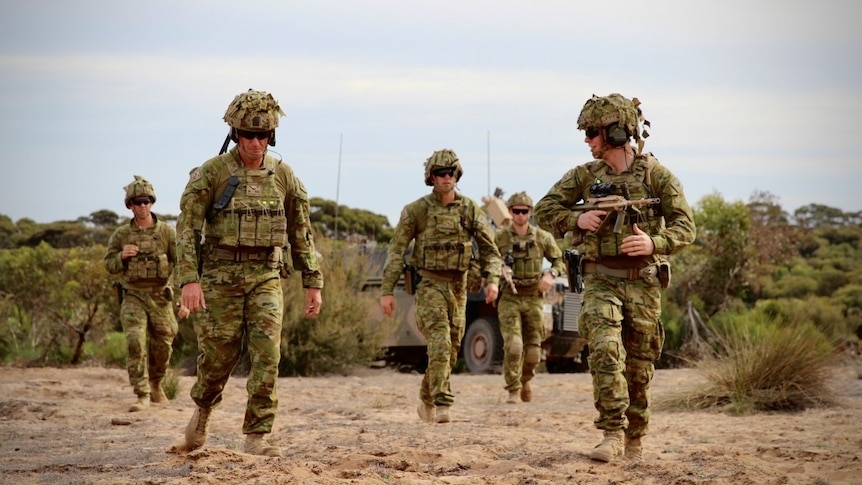 |
| Photo: ABC |
Formed in March 1901, following federation, the Australian Army initially consisted of the six, disbanded and separate, colonial military forces' land components. Due to the Army being continuation of the colonial armies, it became immediately embroiled in conflict with the Second Boer War as contingents had been committed to fight for the United Kingdom of Great Britain and Ireland. The Army gained command of these contingents and even supplied federal units to reinforce their commitment at the request of the British government.
The Defence Act 1903, established the operation and command structure of the Australian Army. In 1911, the Universal Service Scheme was implemented, introducing conscription for the first time in Australia, with males aged 14–26 assigned into cadet and CMF units; though the scheme did not prescribe or allow overseas service outside the states and territories of Australia. This restriction would be primarily, and continually, bypassed through the process of raising separate volunteer forces until the mid-20th century; this solution was not without its drawbacks, as it caused logistical dilemmas.
World War I
After the declaration of war on the Central Powers, the Australian Army raised the all volunteer First Australian Imperial Force (AIF) which had an initial recruitment of 52,561 out of a promised 20,000 men. A smaller expeditionary force, the Australian Naval and Military Expeditionary Force (ANMEF), dealt with the issue of the German Pacific holdings. ANMEF recruitment began on 10 August 1914, and operations started 10 days later. On 11 September, the ANMEF landed at Rabaul to secure German New Guinea, with no German outposts in the Pacific left by November 1914. During the AIF's preparations to depart Australia, the Ottoman Empire joined the Central Powers; thereby receiving declarations of war from the Allies of World War I in early November 1914.
After initial recruitment and training, the AIF departed for Egypt where they underwent further preparations, and where the Australian and New Zealand Army Corps (ANZAC) was formed. Their presence in Egypt was due to the planned Gallipoli campaign, an invasion of the Ottoman Empire via Gallipoli. On 25 April, the AIF landed at ANZAC Cove, which signaled the start of Australia's contribution to the campaign. Following little initial success, fighting quickly devolved into trench warfare, which precipitated a stalemate. On 15 December 1915, after eight months of fighting, the evacuation of Gallipoli commenced; it was completed 5 days later with no casualties recorded. After regrouping in Egypt, the AIF was split into two groups and further expanded with reinforcements. This division would see a majority of the Australian Light Horse fight the Ottomans in Arabia and the Levant, whereas the rest of the AIF would go to the Western Front.
World War II
Following the declaration of war on Nazi Germany and her allies by the United Kingdom, and the subsequent confirmation by Prime Minister Robert Menzies on 3 September 1939, the Australian Army raised the Second Australian Imperial Force, a 20,000-strong volunteer expeditionary force, which initially consisted of the 6th Division; later increased to include the 7th and 9th Divisions, alongside the 8th Division which was sent to Singapore. In October 1939, compulsory military training recommenced for unmarried men aged 21, who had to complete three months of training.
The 2nd AIF commenced its first operations in North Africa with Operation Compass, that began with the Battle of Bardia. This was followed by supplying Australian units to defend against the Axis in the Battle of Greece. After the evacuation of Greece, Australian troops took part in the Battle of Crete which, though more successful, still failed and another withdrawal was ordered. During the Greek Campaign, the Allies were pushed back to Egypt and the Siege of Tobruk began. Tobruk's primary defence personnel were Australians of the 9th Division; the so-called 'Rats of Tobruk'. Additionally, the AIF participated in the Syria–Lebanon campaign. The 9th Division fought in the First and Second Battle of El Alamein before also being shipped home to fight the Japanese.
Cold War
Postwar
After the surrender of Japan, Australia provided a contingent to the British Commonwealth Occupation Force (BCOF) which included the 34th Brigade. The units that composed the brigade would eventually become the nucleus of the regular army, with the battalions and brigade being renumbered to reflect this change. Following the start of the Korean War, the Australian Army committed troops to fight against the North Korean forces; the units came from the Australian contribution to BCOF. The 3rd Battalion, Royal Australian Regiment (3RAR) arrived in Pusan on 28 September 1950. Australian troop numbers would increase and continue to be deployed up until the armistice, with 3RAR being eventually joined by the 1st Battalion, Royal Australian Regiment (1RAR). For a brief period, between 1951 and 1959, the Menzies Government reinstituted conscription and compulsory military training with the National Service Scheme, which required all males of eighteen years of age to serve for specified period in either the Australian Regular Army (ARA) or CMF.
Irregular warfare
Further information: Military history of Australia during the Malayan Emergency and Military history of Australia during the Indonesia–Malaysia confrontation
In October 1955, the Australian Army committed the 2nd Battalion, Royal Australian Regiment (2RAR) in the Malayan Emergency, a guerrilla conflict between communist forces and the Federation of Malaya over ethnic Chinese citizenship. The operations consisted of patrolling actions and guarding infrastructure, though they rarely saw combat as the emergency was nearly over by the time of their deployment. All three original Royal Australian Regiment battalions would complete at least one tour before the end of operations. In August 1963, Australia ended deployments to Malaya, three years after the emergency's official end.
In 1962, the Borneo Confrontation began, due to Indonesia's opposition to the formation of Malaysia. It was an undeclared war that entailed a series of border conflicts between Indonesian-backed forces and British–Malaysian allies. Initial Australian support in the conflict began, and continued throughout, with the training and supply of Malaysian troops; Australian soldiers were only used for combat in defensive operations. In January 1965, permission was granted for the deployment of 3RAR, with extensive operations conducted in Sarawak from March until their withdrawal in July 1965. The subsequent deployment of 4th Battalion, Royal Australian Regiment (4RAR), in April 1966, was less intensive, with the battalion withdrawn in August that year. This is not to mention the efforts of the Special Air Service Regiment and several other corps in the conflict.
Vietnam War
Further information: Military history of Australia during the Vietnam War
The Australian Army commenced its involvement in the Vietnam War by sending military advisors in 1962, which was then increased by sending in combat troops, specifically 1RAR, on 27 May 1965. Just before the official start of hostilities, the Australian Army was augmented with the reintroduction of conscription, which was based on a 'birthday ballot' selection process for all registered 20-year-old males. These men were required to register, unless they gave a legitimate reason for their exemption, else they faced penalties. This scheme would prove to be one of the most controversial implementations of conscription in Australia, with large protests against its adoption.
In March 1966, the Australian Army increased its commitment again with the replacement of 1RAR with the 1st Australian Task Force, a force in which all nine battalions of the Royal Australian Regiment would serve. One of the heaviest actions of the war occurred in August 1966, with the Battle of Long Tan, wherein D Company, 6th Battalion, Royal Australian Regiment (6RAR) successfully fended off an enemy force, estimated at 2,000 men, for four hours. In 1968, Australian forces defended against the Tet Offensive, a Viet Cong military operation, and repulsed them with few casualties. The contribution of personnel to the war was gradually wound down, starting in late-1970 and ending in 1972; the official declaration of the end of Australia's involvement in the war was made on 11 January 1973.
Post–Vietnam War
Following the Vietnam War, there was an almost continuous hiatus of operational activity by the Australian Army. In late 1979, one of the largest deployments experienced by the Army during this period was its commitment of 151 troops to the Commonwealth Monitoring Force, which monitored the transition of Rhodesia to universal suffrage. In 1989, Australia offered 300 army personnel, mostly engineers, to the United Nations Transition Assistance Group (UNTAG) in Namibia, to help transition the country to independence from South Africa control.
1991–presentIn 2000, the Federation Guard was formed – this was a tri-service unit consisting of personnel from the army, RAN and RAAF to serve as ceremonial guards during the celebrations of Australia's Centenary of Federation the following year. In July 2000, a detachment mounted the Queen's Guard in London for three weeks; this included four women, under the command of Captain Cynthia Anderson. These were the first women ever to serve as guards at Buckingham Palace. In August 2009, an alleged plan to attack the Holsworthy Barracks was uncovered by the Australian Federal Police. The alleged terrorist plot was to storm Holsworthy Barracks, a training area and artillery range for the Australian Army located in the outer south-western Sydney suburb of Holsworthy, with automatic weapons; and shoot army personnel or others until they were killed or captured. Australia was one of the countries to provide combat forces for the US-led invasion of Iraq. In Australia it was known as Operation Falconer. In all Australia contributed some 2,000 personnel. The Army contribution to this was 500 soldiers. Following the end of major combat operations, Australia announced a withdrawal of most of its forces in Iraq. It left behind approximately 950 troops in the theatre. These included naval forces, support troops (such as air traffic controllers) and a security detachment of about 75 soldiers in strength to defend key Australian interests. In February 2005, Prime Minister John Howard announced an increase in the Australian presence by about 450 to provide protection for Japanese troops and assist in training Iraqi troops. This force, designated the Al Muthanna Task Group, was deployed to Southern Iraq in May 2005. After Al Muthanna province gained provincial control in mid 2006, the Australian force transitioned into a new role and was retitled the Overwatch Battle Group. OBG(W) relocated its forward operating base from Camp Smitty (outskirts of As Samawah, Al Muthanna province) to Tallil Air Base (outskirts of Nasiriyah, Dhi Qar province) effectively co-locating with the Australian Army Training Team Iraq (AATTI). Australia's contribution to operations in Southern Iraq involved combat overwatch of both Al Muthanna and Dhi Qar province, conduct of CIMIC operations and provision of support and training to the Iraqi Security Forces. After the Labor Government gained power in late 2007, most Australian forces were withdrawn from Iraq in mid-2008. |
Australian Military branches
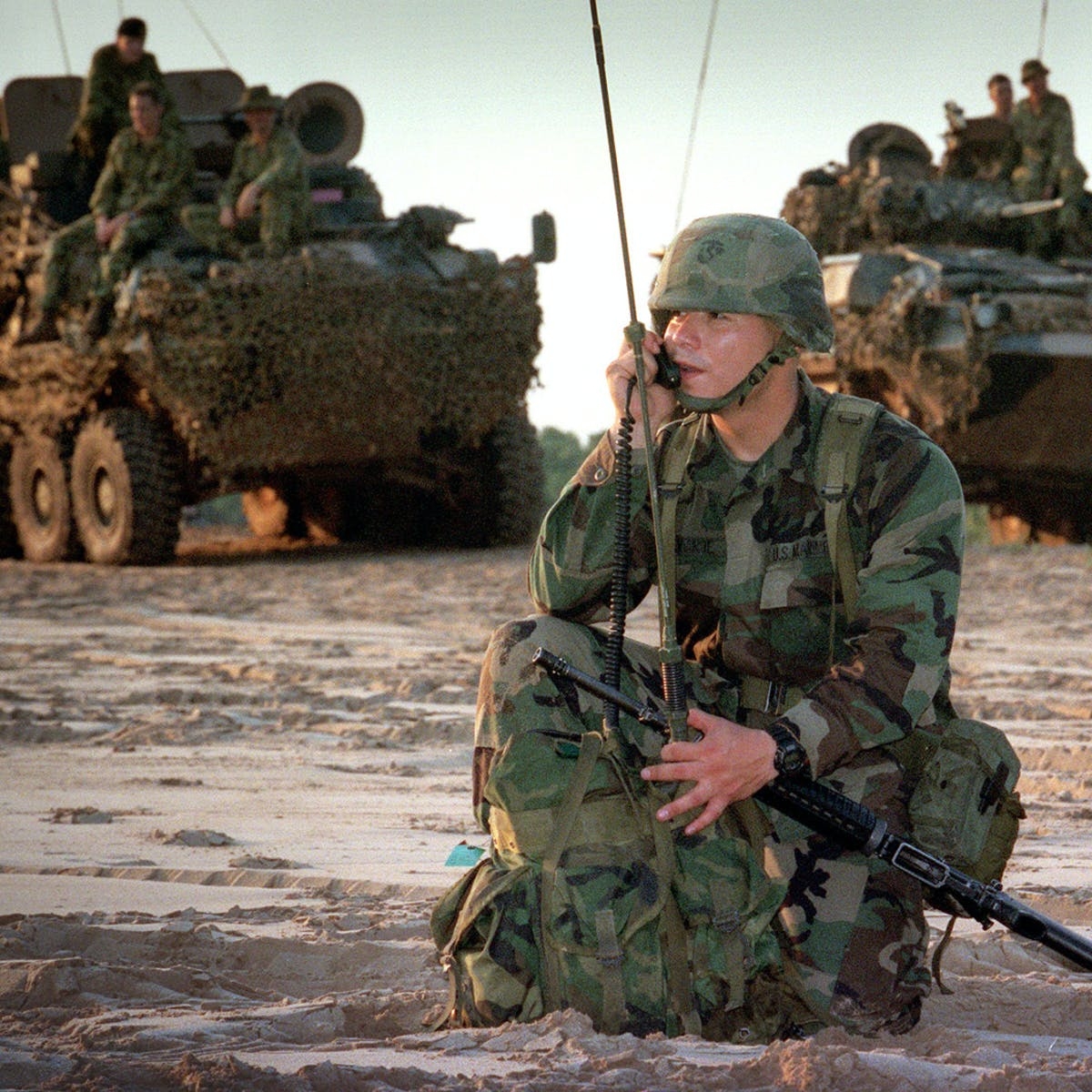 |
| Photo: The Conversation |
1st Division
The 1st Division carries out high-level training activities and deploys to command large-scale ground operations. It has few combat units permanently assigned to it, although it does currently command the 2nd Battalion, Royal Australian Regiment as part of Australia's amphibious task group.
Forces Command
Forces Command controls for administrative purposes all non-special-forces assets of the Australian Army. It is neither an operational nor a deployable command. Forces Command comprises:
1 Brigade – Multi-role Combat Brigade based in Darwin and Adelaide.
3 Brigade – Multi-role Combat Brigade based in Townsville.
6 Brigade (CS&ISTAR) – Mixed brigade based in Sydney.
7 Brigade – Multi-role Combat Brigade based in Brisbane.
17 Sustainment Brigade – Logistic brigade based in Sydney.
2nd Division administers the reserve forces from its headquarters located in Sydney.
4 Brigade – based in Victoria.
5 Brigade – based in New South Wales.
8 Brigade – training brigade with units around Australia
9 Brigade – based in South Australia and Tasmania.
11 Brigade – based in Queensland.
13 Brigade – based in Western Australia.
Additionally, Forces Command includes the following training establishments:
Army Recruit Training Centre at Kapooka, NSW;
Royal Military College, Duntroon in the ACT;
Combined Arms Training Centre at Puckapunyal, Vic; and
Army Logistic Training Centre at Bonegilla, Vic and Bandiana, Vic.
Aviation
Army Aviation Command is responsible for the Australian Army's helicopters and training, aviation safety and unmanned aerial vehicles (UAV). Army Aviation Command comprises:
16 Aviation Brigade – brigade based in Enoggera, Brisbane.
Army Aviation Training Centre at Oakey, QLD.
Special Forces
Special Operations Command is a command formation of equal status to the other commands in the ADF and includes all of Army's special forces units. Special Operations Command comprises:
Special Forces Group - a brigade-level headquarters.
Australia Military Strength And Powers
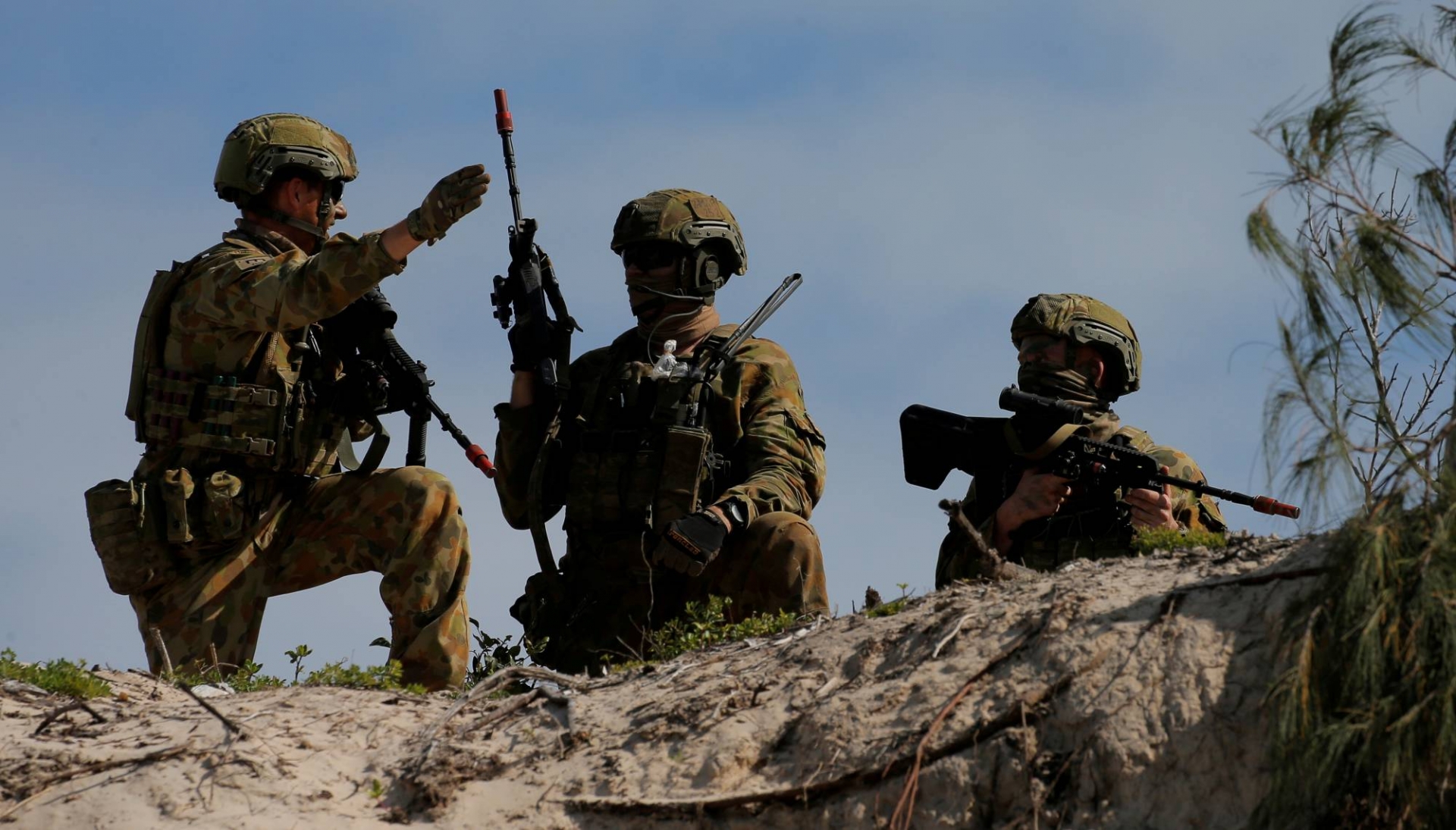 |
| Photo: Japan Times |
For 2022, Australia is ranked 17 of 140 out of the countries considered for the annual GFP review. It holds a PwrIndx score of 0.2377 (a score of 0.0000 is considered 'perfect').
According to the index, Australia has an active military comprising of 60,000 personnel while India has 1,362,500 while China 2,183,000, Pakistan has 637,000 while Bangladesh has 160,000 military personnel.
According to the report, Australia Army has a total of 59 combat tanks and 2040 armoured fighting vehicles.
Bangladesh Army has a total of 534 combat tanks, 942 armoured fighting vehicles, 18 self-propelled artillery guns, no-towed artillery guns and 32 rocket projectors.
The report also says Australia has a total of 47 Naval assets. The country owns 10 frigates, two aircraft carriers, six submarines and six mine warfare vessels.
Australian military personnel
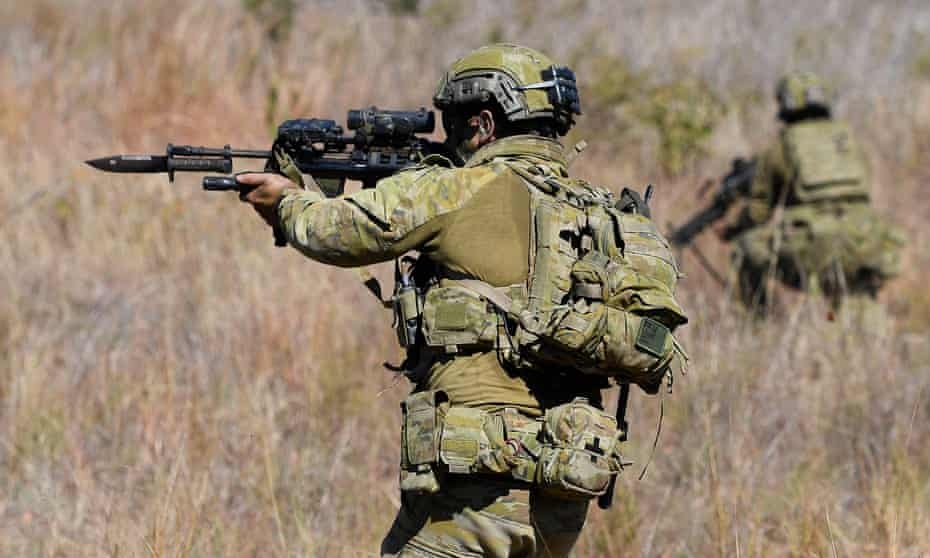 |
| Photo: The Guardian |
The Australian military has been an all-volunteer force since the abolition of conscription in 1972. Both men and women can enlist in the ADF, with women being able to apply for all roles. Only Australian citizens and permanent residents who are eligible for Australian citizenship can enlist. Recruits must be aged at least 17, and meet health, educational and aptitude standards. The ADF is one of the few areas of the Australian Government to continue to have compulsory retirement ages: permanent personnel must retire at 60 years of age and reservists at 65. Both permanent and reserve personnel can work through flexible arrangements, including part-time hours or remotely from their duty station, subject to approval. Discipline of defence personnel is guided by the Defence Force Discipline Act (1982), ultimately overseen by the Judge Advocate General of the ADF.
Personnel numbers
As of 30 June 2020, the ADF comprised 59,095 permanent (full-time) and 28,878 active reserve (part-time) personnel. There were 22,166 inactive members of the Standby Reserve as at June 2009. The Army is the largest service, followed by the RAAF and RAN. The ADO also employed 17,454 civilian Australian Public Service (APS) staff as at 30 June 2020. During the 2019–20 financial year 6,277 people enlisted in the ADF on a permanent basis and 5,240 left, representing a net increase of 1,037 personnel.
The distribution of ADF personnel between the services and categories of service on 30 June 2020 was as follows:
| Service | Permanent | Active Reserve | Total |
| Navy | 15,027 | 3,632 | 18,659 |
| Army | 29,627 | 19,632 | 49,259 |
| Air Force | 14,441 | 5,614 | 20,055 |
| Total | 59,095 | 28,878 | 87,973 |
The number of ADF personnel has changed over the last 20 years. During the 1990s the strength of the ADF was reduced from around 70,000 to 50,000 permanent personnel as a result of budget cuts and the outsourcing of some military functions. The ADF began to grow from 2000 after the defence white paper released that year called for an expansion to the military's strength, though the size of the military decreased between the 2003–04 to 2005–06 financial years due to problems with attracting further recruits. By 2009–10 the ADF was above its budgeted size, leading to reductions until 2014–15. The size of the ADF grew between the 2014–15 and 2016–17 financial years. The ADF has not met its recruitment targets over the period since the 1995–96 financial year.
The ADF is small compared to many other national militaries. Both the number of personnel in the ADF and the share of the Australian population this represents is smaller than that in many countries in Australia's immediate region. Several NATO member countries, including France and the United States, also have a higher share of their population in the military. This is a continuation of long-term trends, as outside of major wars Australia has always had a relatively small military. The size of the force is a result of Australia's relatively small population and the military being structured around a maritime strategy focused on the RAN and RAAF rather than a manpower-intensive army.
 British Army - Top 8th Strongest Militaries In The World British Army - Top 8th Strongest Militaries In The World United Kingdom is ranked 8 of 140 out of the countries considered for the annual Global Firepower Index (GFP) review. How UK Has The 8th ... |
 Ukrainian Army - Top 22nd Strongest Militaries in The World Ukrainian Army - Top 22nd Strongest Militaries in The World The Armed Forces of Ukraine is the military of Ukraine. Here is the military history of Ukraine, and how this country has become the world's ... |
 Russian Army - Top 2nd Strongest Militaries in the World Russian Army - Top 2nd Strongest Militaries in the World Russia is ranked 2 of 140 out of the countries considered for the annual The Global Firepower Index (GFP) review. We will learn about the ... |
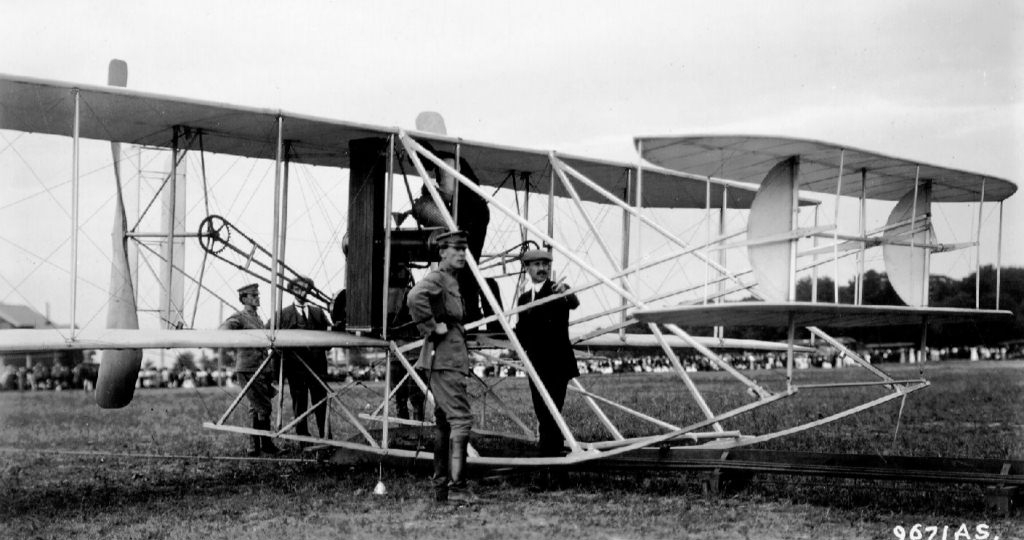 What Is The First Military Airplane In The World? What Is The First Military Airplane In The World? The 1909 Wright Military Flyer is the world's first military airplane. Read on to know its history. |























